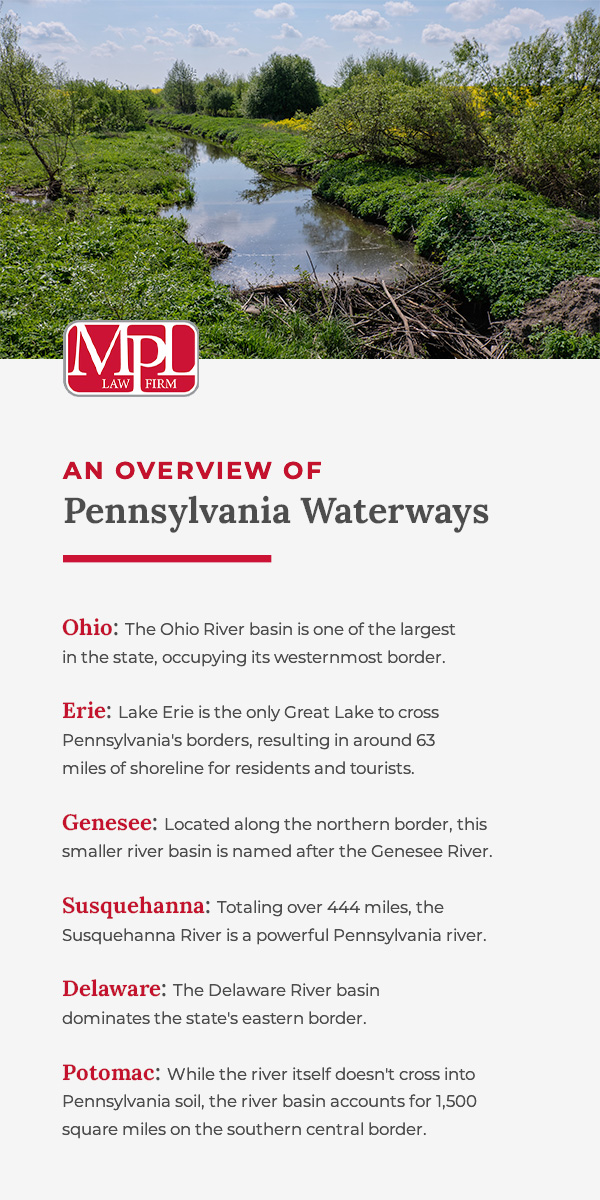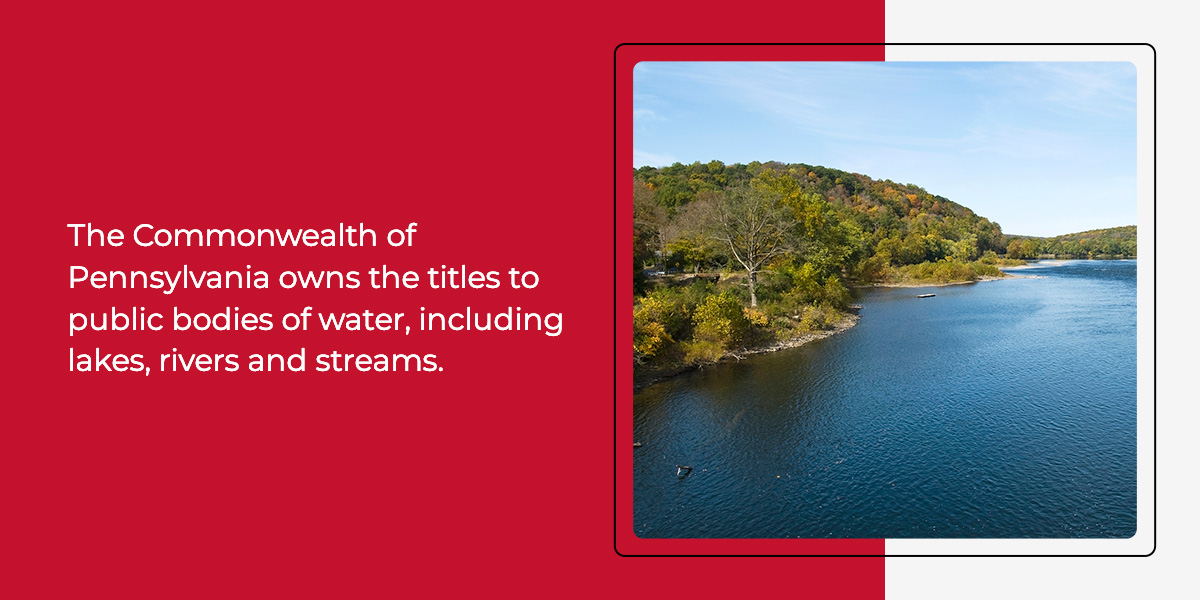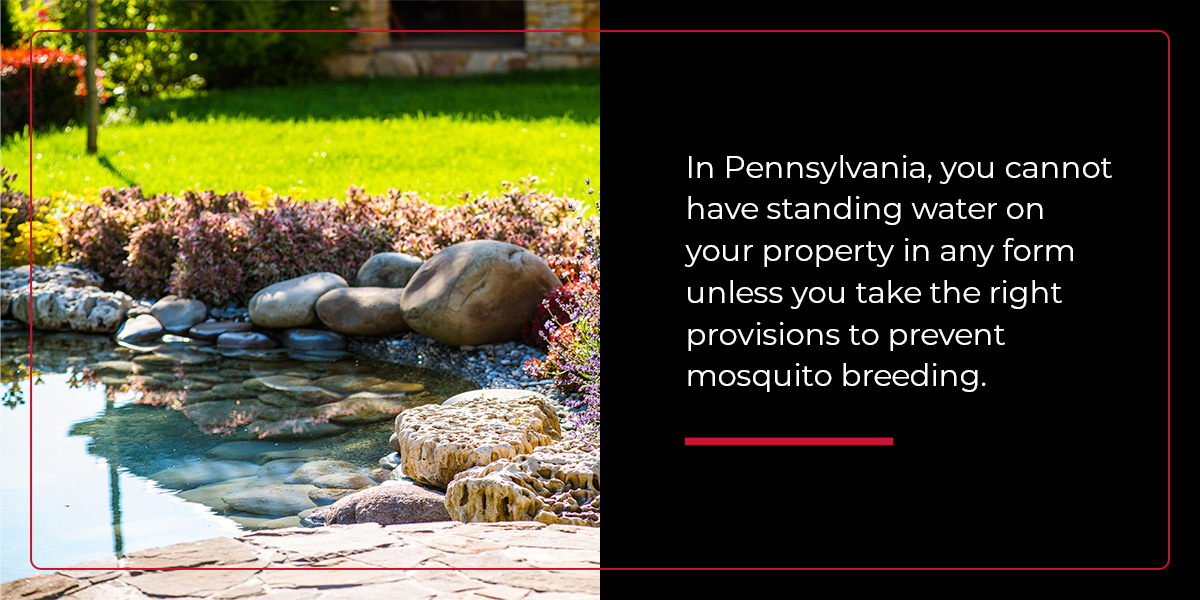Guide to Pennsylvania Riparian Water Rights
Updated: 3/8/2023
Water ownership is a challenging topic. With many nuances and exceptions, your rights might depend on various circumstances. Pennsylvania has established requirements determining water ownership and access legislation, helping landowners understand their rights.
Our guide outlines the various terms and situations you might need to know when approaching water ownership issues.
An Overview of Pennsylvania Waterways
Even as a state without ocean access, Pennsylvania is rich in waterways. Here, you can find several rivers, lakes, reservoirs, streams and other bodies of water. Overall, this state is home to six major watersheds and river basins:
- Ohio: The Ohio River basin is one of the largest in the state, occupying its westernmost border. It accounts for around 15,600 square miles in Pennsylvania and impacts over 3.5 million state residents who use the waters for drinking, producing electricity and transportation.
- Erie: Lake Erie is the only Great Lake to cross Pennsylvania’s borders, resulting in around 63 miles of shoreline for residents and tourists. This lake is popular for recreational and fishing applications because of its warmer temperatures and rich aquatic life.
- Genesee: Located along the northern border, this smaller river basin is named after the Genesee River. It stretches only 11 miles into the state but continues into several other states.
- Susquehanna:Totaling over 444 miles, the Susquehanna River is a powerful Pennsylvania river. Its basin covers most of central Pennsylvania and accounts for a large portion of the freshwater that flows into the Chesapeake Bay, making it a crucial watershed.
- Delaware: The Delaware River basin dominates the state’s eastern border. It accounts for over 6,400 square miles of Pennsylvania and stretches into several New England and mid-Atlantic states.
- Potomac: While the river itself doesn’t cross into Pennsylvania soil, the river basin accounts for 1,500 square miles on the southern central border. Like the Susquehanna, waterways in this watershed provide freshwater to the Chesapeake Bay.
When you understand what Pennsylvania’s water systems look like, you can start applying the various water rights in the Keystone State.
What Are Riparian Rights?
Riparian rights are a system used to determine who can access and use water based on property ownership. Under a system of riparian rights, water rights sit with those owning the land bordering the body of water. Landowners cannot sell or sever their riparian rights — the rights only change when new owners acquire properties. Even if riparian rights are not specified or acknowledged in deeds or contracts, the transfer runs with the land and is implied.
Because riparian rights depend on land that borders waterways, several property owners might have rights over one waterway. Each landowner has the same set of rights and restrictions, regardless of factors like ownership length or the amount of property owned. New property owners will have the same rights and priorities as existing and long-term owners.
Generally, riparian rights provide property owners with three main rights — access to their bordered waterway, access to their property through the water and use of the water from bordering bodies.
Riparian rights are generally used in eastern states, while western ones have separate rules. While only some states use riparian rights, most states east of the Mississippi use it, including Pennsylvania.
Pennsylvania Riparian Rights
Pennsylvania has unique riparian rights and specifications. If you own a shoreline, or littoral, property, knowing your rights and restrictions can help you optimize your water use and property rights. In Pennsylvania, riparian rights can apply to surface and groundwater.
Riparian rights in Pennsylvania protect several types of activities. Domestic applications always take priority over other uses. Domestic water use might involve implementing bodies of water for drinking, bathing, laundry and maintaining livestock. Industrial and municipal rights come second to these applications.
While riparian rights give landowners the right to use and access waterways on their properties, riparians have no ownership of the water itself. The Commonwealth of Pennsylvania owns the titles to public bodies of water, including lakes, rivers and streams. Any activity on the water must follow the state government’s guidelines and requirements.
Riparian rights in Pennsylvania do not apply to humanmade structures or bodies of water unless they replace an existing natural one. When land borders a humanmade body of water like a reservoir, all landowners can agree to treat the water as if they were riparians. This exception allows landowners to use and access artificial water sources.
Individuals also cannot divert riparian water sources in this state, which might limit how you might use your property. For example, you cannot redirect river water to cut through your property. Riparian rights only apply to natural waterways and movements.
Pennsylvania Surface Water Rights
Pennsylvania littoral rights apply to above-ground bodies of water in defined lakes and streams. Your rights to the water only stretch as far as your property’s borders, limiting the space you might be allowed to access or use.
When discussing surface water rights, you must consider navigation. Bodies of water are navigable if they can be used for commercial purposes in any condition. The public is allowed to use navigable waterways for recreation no matter who owns the land under the water. However, if bodies of water are non-navigable, ownership and regulation belong to those who own the land under and bordering it.
If waterways border multiple properties, they are also navigable. In these instances, property owners only have the right to use and access the bordering water.
Pennsylvania Groundwater Rights
Pennsylvania also protects property owners’ rights to use groundwater, which is a subterranean water source. For example, you can use groundwater riparian rights to draw water to your property through a well. However, owners must use that water on their property, and off-site applications are not allowed.
Multiple properties might be able to draw water from the same source. However, Pennsylvania requires that all groundwater use be reasonable. You can withdraw groundwater for personal use, but it cannot harm other users. Pennsylvania does not limit how much water you can withdraw from underground sources, so users may deplete their neighbors’ supply as long as the use is reasonable and legal.
Pennsylvania Standing Water Rights
Standing water has no movement or drainage. These bodies of water are often at risk of becoming breeding grounds for mosquitoes. In Pennsylvania, you cannot have standing water on your property in any form unless you take the right provisions to prevent mosquito breeding. Standing water restrictions apply to manufactured and natural sources of standing water. Some types of standing water include ponds, basins and containers.
Example Case of Water Rights in Pennsylvania
Because Pennsylvania water rights are complicated, court cases and water use disputes can help individuals understand the nuances and exceptions to these rights. Riparian rights disputes can occur between individuals or organizations.
In the case of Village of Four Seasons Association, Inc. v. Elk Mountain Ski Resort, Inc., a panel of the Pennsylvania Superior Court tried to answer this question — who owns the water? This case specifically addresses navigable bodies of water and how land ownership impacts water use. You can use this case to help you understand these riparian rights concepts better.
For background, Elk Mountain Ski Resort owns a small pond that shares a boundary with a lake used by the Village of Four Seasons. The lake has a breach in its berm that feeds Elk Mountain’s snow-making pond. The Village of Four Seasons sought an injunction to close the breach in the lake that fed the snow-making pond. The Superior Court reversed a lower court ruling that found the Village of Four Seasons owned the land under its lake and, therefore, owned all of the water in the lake.
Through this case, the Superior Court provided a good summary of Riparian Law in Pennsylvania. The Commonwealth owns navigable bodies of water. Because the lake in question is landlocked and non-navigable, its ownership belongs to the party that owns the land below it and along its borders. The lake and pond are both non-navigable. However, a non-navigable body of water that flows or is a tributary of a flowing body of a watercourse is not owned by anyone. When water flows between or past properties, the water qualifies for shared riparian rights, giving each property owner use and access to the water.
Therefore, if Elk Mountain can establish that the water flowing through the lake and the snow-making pond is moving water with an inlet and an outlet, Elk Mountain would have the right to make reasonable use of the water so long as it does not interfere with the reasonable use of the water by the Village of Four Seasons. The case was referred back to the lower court for trial on this factual issue.
The case presents an interesting factual question that must be answered before one can even answer the ultimate question of water ownership — what is flowing water? Is a pond or lake fed by underground springs that have an “on-again-off-again” overflow breach or spillway a flowing body of water?
As a side note in this case, the court also reinforced the fact that a consumptive use permit granted to Elk Mountain by the Susquehanna River Basin Commission (SRBC) confers no ownership rights to the water covered by the withdrawal permit.
The SRBC has no power to determine or regulate property or riparian rights, but the withdrawal permit does raise a factual issue of whether the lake and pond are part of a watercourse that eventually drains into the Susquehanna River. Presumptively, this must be the case for SRBC to exercise its jurisdiction.
Partner With MPL Law to Learn Your Riparian Rights
Navigating riparian rights and laws alone can be challenging. Pennsylvania uses common law and commissions to regulate and enforce riparian rights rulings for individuals and businesses. Having the right team can help you understand and protect your rights. MPL Law offers municipal and real estate law services, helping answer your questions and develop an actionable plan to secure your riparian rights.
When you partner with MPL Law, you can trust us to listen to your case and needs. We will develop a plan depending on your desired outcome and situation, bringing unparalleled honesty to our advice and services.
If you have a question regarding riparian rights or real estate law in Pennsylvania, contact MPL Law today.







Leave a Reply